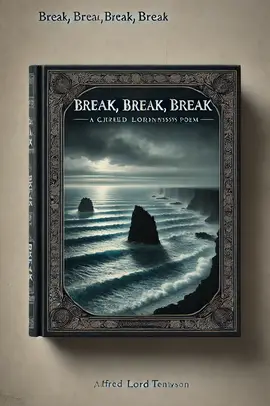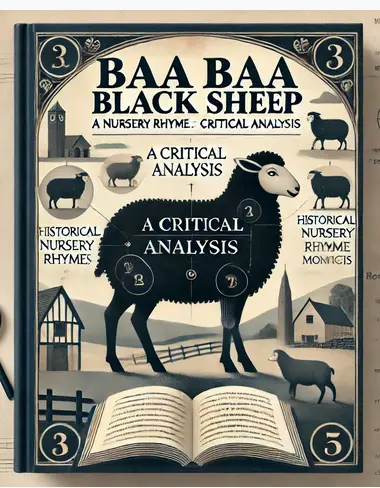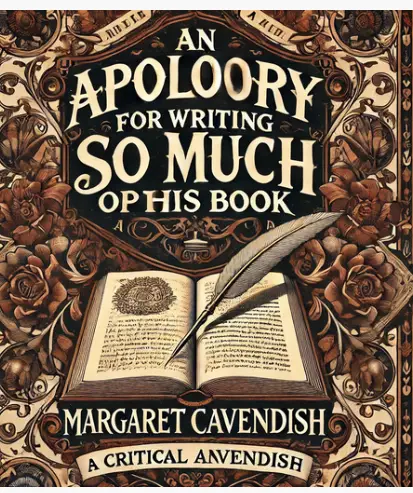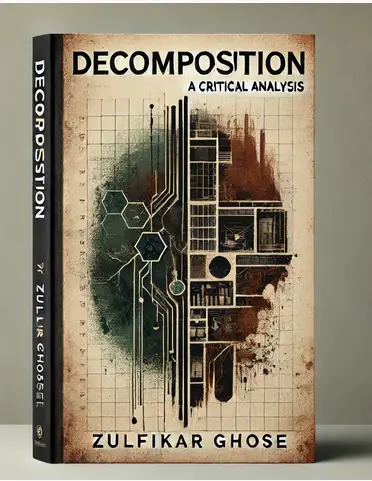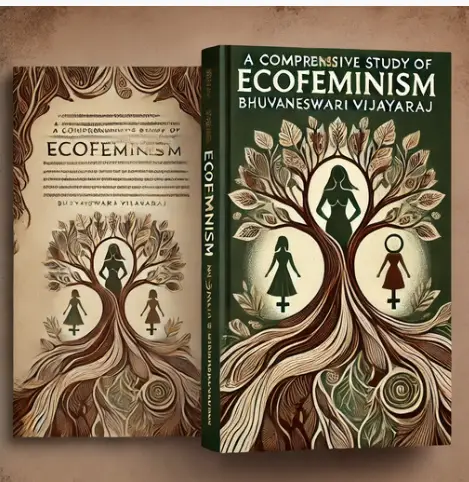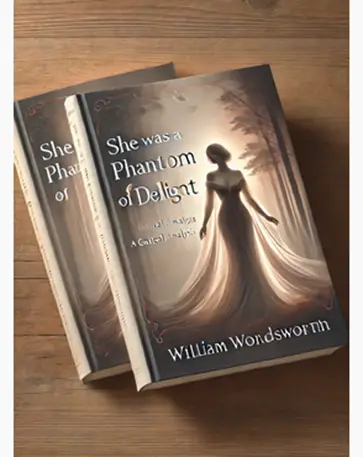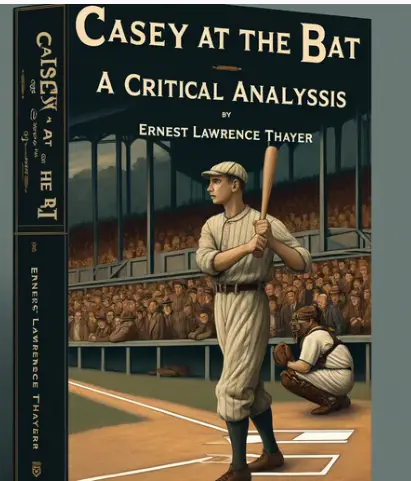
Introduction: “Casey at the Bat” by Ernest Lawrence Thayer
“Casey at the Bat” by Ernest Lawrence Thayer, first appeared in the San Francisco Examiner on June 3, 1888, is set in the fictional town of Mudville, captures the drama of a high-stakes baseball game where the hopes of the crowd rest on the star batter, Casey. Thayer’s narrative uses suspense and humor, culminating in Casey’s unexpected and heartbreaking strikeout. The poem’s main ideas revolve around themes of pride, overconfidence, and the unpredictability of fate, as it challenges the assumption that talent alone guarantees success. Its enduring popularity can be attributed to its vivid storytelling, relatable themes, and memorable rhythm, making it a classic not only in sports literature but also in American culture. The poem’s humorous twist and exploration of human error resonate widely, endearing it to generations of readers and securing its place as a cultural staple in American poetry and folklore.
Text: “Casey at the Bat” by Ernest Lawrence Thayer
The outlook wasn’t brilliant for the Mudville nine that day:
The score stood four to two, with but one inning more to play,
And then when Cooney died at first, and Barrows did the same,
A pall-like silence fell upon the patrons of the game.
A straggling few got up to go in deep despair. The rest
Clung to the hope which springs eternal in the human breast;
They thought, “If only Casey could but get a whack at that—
We’d put up even money now, with Casey at the bat.”
But Flynn preceded Casey, as did also Jimmy Blake,
And the former was a hoodoo, while the latter was a cake;
So upon that stricken multitude grim melancholy sat,
For there seemed but little chance of Casey getting to the bat.
But Flynn let drive a single, to the wonderment of all,
And Blake, the much despisèd, tore the cover off the ball;
And when the dust had lifted, and men saw what had occurred,
There was Jimmy safe at second and Flynn a-hugging third.
Then from five thousand throats and more there rose a lusty yell;
It rumbled through the valley, it rattled in the dell;
It pounded on the mountain and recoiled upon the flat,
For Casey, mighty Casey, was advancing to the bat.
There was ease in Casey’s manner as he stepped into his place;
There was pride in Casey’s bearing and a smile lit Casey’s face.
And when, responding to the cheers, he lightly doffed his hat,
No stranger in the crowd could doubt ’twas Casey at the bat.
Ten thousand eyes were on him as he rubbed his hands with dirt;
Five thousand tongues applauded when he wiped them on his shirt;
Then while the writhing pitcher ground the ball into his hip,
Defiance flashed in Casey’s eye, a sneer curled Casey’s lip.
And now the leather-covered sphere came hurtling through the air,
And Casey stood a-watching it in haughty grandeur there.
Close by the sturdy batsman the ball unheeded sped—
“That ain’t my style,” said Casey. “Strike one!” the umpire said.
From the benches, black with people, there went up a muffled roar,
Like the beating of the storm-waves on a stern and distant shore;
“Kill him! Kill the umpire!” shouted someone on the stand;
And it’s likely they’d have killed him had not Casey raised his hand.
With a smile of Christian charity great Casey’s visage shone;
He stilled the rising tumult; he bade the game go on;
He signaled to the pitcher, and once more the dun sphere flew;
But Casey still ignored it and the umpire said, “Strike two!”
“Fraud!” cried the maddened thousands, and echo answered “Fraud!”
But one scornful look from Casey and the audience was awed.
They saw his face grow stern and cold, they saw his muscles strain,
And they knew that Casey wouldn’t let that ball go by again.
The sneer is gone from Casey’s lip, his teeth are clenched in hate,
He pounds with cruel violence his bat upon the plate;
And now the pitcher holds the ball, and now he lets it go,
And now the air is shattered by the force of Casey’s blow.
Oh, somewhere in this favoured land the sun is shining bright,
The band is playing somewhere, and somewhere hearts are light;
And somewhere men are laughing, and somewhere children shout,
But there is no joy in Mudville—mighty Casey has struck out.
Annotations: “Casey at the Bat” by Ernest Lawrence Thayer
| Stanza | Annotation |
| The outlook wasn’t brilliant for the Mudville nine that day: | The poem begins with a bleak scenario for Mudville’s baseball team, down by two runs with only one inning left to play. Thayer sets a tone of desperation and tension, creating suspense about whether the team can turn their luck around. |
| The score stood four to two, with but one inning more to play, | The specific score and timing introduce the stakes: Mudville needs to score to avoid defeat. The phrasing emphasizes the finality of their last chance. |
| And then when Cooney died at first, and Barrows did the same, | The first two batters fail, metaphorically “dying” on first base, which increases the audience’s despair. Thayer uses baseball terminology that heightens the reader’s sense of tension and loss. |
| A pall-like silence fell upon the patrons of the game. | The “pall-like silence” suggests a funereal atmosphere, with the fans preparing for disappointment, as if witnessing a death. Thayer portrays the audience’s emotional investment in the game. |
| A straggling few got up to go in deep despair. The rest | Some fans begin to leave, losing hope, while others stay, symbolizing the perseverance of hope in human nature, which will be a recurring theme. |
| Clung to the hope which springs eternal in the human breast; | The famous line about “hope which springs eternal” implies that, despite odds, fans hope for a miracle, reflecting human optimism and resilience in difficult situations. |
| They thought, “If only Casey could but get a whack at that— | The audience begins to pin all their hopes on Casey, Mudville’s star player. This sets up Casey as a hero figure, hinting at his skill and reputation. |
| We’d put up even money now, with Casey at the bat.” | Fans are so confident in Casey’s abilities that they would bet on him, underscoring their faith in him and building anticipation for his appearance. |
| But Flynn preceded Casey, as did also Jimmy Blake, | Lesser-known players, Flynn and Blake, come up to bat before Casey. The crowd sees these players as obstacles to Casey’s turn, adding to the suspense. |
| And the former was a hoodoo, while the latter was a cake; | Flynn is labeled a “hoodoo” (a bringer of bad luck) and Blake a “cake” (ineffective), underscoring the fans’ low expectations and emphasizing Casey as the savior they await. |
| So upon that stricken multitude grim melancholy sat, | The mood of the crowd is described as “grim melancholy,” reflecting their disappointment and the perceived futility of winning without Casey. |
| For there seemed but little chance of Casey getting to the bat. | Fans are doubtful that Casey will get his chance, making the build-up to his entrance more impactful. |
| But Flynn let drive a single, to the wonderment of all, | Flynn surprises everyone by hitting the ball, challenging the crowd’s low expectations and giving Mudville a glimmer of hope. |
| And Blake, the much despisèd, tore the cover off the ball; | Blake also performs unexpectedly well, hitting the ball powerfully. The phrase “tore the cover off the ball” is a metaphor for a strong hit, surprising the fans and intensifying their excitement. |
| And when the dust had lifted, and men saw what had occurred, | Thayer uses imagery here to convey the chaotic excitement, creating a moment of suspense as the crowd waits to see the results of Blake’s hit. |
| There was Jimmy safe at second and Flynn a-hugging third. | Blake’s hit advances both runners, putting them in a scoring position and giving Mudville a real chance. The stakes are raised, setting up Casey’s critical role. |
| Then from five thousand throats and more there rose a lusty yell; | The crowd’s anticipation and enthusiasm reach a fever pitch as they sense a possible comeback, showing the collective power of their hope and excitement. |
| It rumbled through the valley, it rattled in the dell; | The cheers reverberate, symbolizing the overwhelming excitement and emotional investment of the crowd, making the scene larger-than-life. |
| It pounded on the mountain and recoiled upon the flat, | Thayer uses hyperbole to show the intensity of the crowd’s reaction, almost as if nature itself is involved in their anticipation. |
| For Casey, mighty Casey, was advancing to the bat. | Casey finally steps up to bat, fulfilling the fans’ wishes. The line emphasizes his legendary status as a powerful figure in the eyes of the crowd. |
| There was ease in Casey’s manner as he stepped into his place; | Casey’s relaxed demeanor reflects his confidence and adds to his image as a hero. Thayer paints him as a composed, almost untouchable figure. |
| There was pride in Casey’s bearing and a smile lit Casey’s face. | Casey’s pride is apparent, and his smile suggests that he shares the crowd’s confidence in his abilities, foreshadowing his potential overconfidence. |
| And when, responding to the cheers, he lightly doffed his hat, | Casey acknowledges the crowd’s admiration, reinforcing his role as a star player and crowd favorite. |
| No stranger in the crowd could doubt ’twas Casey at the bat. | Thayer emphasizes Casey’s distinct presence, showing that he is well-known and admired, almost as a larger-than-life character. |
| Ten thousand eyes were on him as he rubbed his hands with dirt; | The hyperbolic number of spectators reflects Casey’s popularity and the intense focus on his every move. |
| Five thousand tongues applauded when he wiped them on his shirt; | Every small action of Casey’s is admired by the crowd, highlighting their adoration and expectation. |
| Then while the writhing pitcher ground the ball into his hip, | The pitcher is portrayed as nervous and tense, contrasting with Casey’s calm confidence. Thayer builds suspense around the upcoming pitch. |
| Defiance flashed in Casey’s eye, a sneer curled Casey’s lip. | Casey’s arrogance and confidence are emphasized, suggesting he may be overestimating his own abilities, foreshadowing possible failure. |
| And now the leather-covered sphere came hurtling through the air, | The description of the ball’s motion builds tension as the moment of action arrives. |
| And Casey stood a-watching it in haughty grandeur there. | Casey’s confidence leads him to ignore the first pitch, a sign of arrogance that sets up his eventual downfall. |
| Close by the sturdy batsman the ball unheeded sped— | Casey’s inaction on the first pitch shows his overconfidence; he lets the ball pass without attempting to hit it. |
| “That ain’t my style,” said Casey. “Strike one!” the umpire said. | Casey dismisses the first strike, reflecting his prideful attitude and adding to the suspense as the audience grows concerned. |
| From the benches, black with people, there went up a muffled roar, | The crowd’s reaction to the strike reflects their growing anxiety and rising emotions, amplifying the tension. |
| Like the beating of the storm-waves on a stern and distant shore; | Thayer uses a simile to compare the crowd’s roar to storm waves, suggesting powerful, growing unrest. |
| “Kill him! Kill the umpire!” shouted someone on the stand; | The crowd’s anger is directed at the umpire, blaming him for the strike, showing their desperation and emotional investment. |
| And it’s likely they’d have killed him had not Casey raised his hand. | Casey, now almost saint-like, calms the crowd, displaying his control and influence over them, which also enhances his heroic image. |
| With a smile of Christian charity great Casey’s visage shone; | Casey’s “Christian charity” is ironic; though he exudes calm, his actions soon show he is prideful, hinting at the impending irony of his failure. |
| He stilled the rising tumult; he bade the game go on; | Casey quiets the crowd, reinforcing his control, confidence, and the crowd’s trust in him. |
| He signaled to the pitcher, and once more the dun sphere flew; | The next pitch is thrown, building suspense as the game approaches its climax. |
| But Casey still ignored it and the umpire said, “Strike two!” | Casey lets the second strike pass, increasing the tension and indicating his hubris. His choice to ignore another pitch foreshadows his possible downfall. |
| “Fraud!” cried the maddened thousands, and echo answered “Fraud!” | The crowd’s anger reaches a peak, blaming the umpire for Casey’s failure, illustrating their desperation and emotional turmoil. |
| But one scornful look from Casey and the audience was awed. | Casey’s dominance over the crowd is emphasized as his reaction silences them, further building his image as a hero who is about to save the day. |
| They saw his face grow stern and cold, they saw his muscles strain, | Thayer portrays Casey’s growing determination, setting up for what the audience believes will be a triumphant hit. |
| And they knew that Casey wouldn’t let that ball go by again. | The crowd believes Casey will succeed this time, showing their faith in him and foreshadowing the shock of his eventual failure. |
| The sneer is gone from Casey’s lip, his teeth are clenched in hate, | Casey becomes serious and focused, preparing for his last chance to redeem himself, while the audience anticipates victory. |
| He pounds with cruel violence his bat upon the plate; | Casey’s intensity and frustration are evident, heightening the anticipation as he readies himself. |
| And now the pitcher holds the ball, and now he lets it go, | The poem reaches its climax as the final pitch is thrown, setting up the reader’s expectations for a dramatic hit. |
| And now the air is shattered by the force of Casey’s blow. | Casey swings with all his strength, adding to the drama and anticipation of success. |
| Oh, somewhere in this favoured land the sun is shining bright, | The tone shifts as the outcome is revealed indirectly, suggesting that happiness exists elsewhere, in contrast to Mudville’s despair. |
| The band is playing somewhere, and somewhere hearts are light; | Thayer softens the conclusion by showing that while Mudville is sad, joy continues elsewhere, implying life goes on despite failures. |
| And somewhere men are laughing, and somewhere children shout, | This stanza paints a serene, happy picture to contrast with the devastation of Mudville, highlighting the universality of triumph and defeat. |
| But there is no joy in Mudville—mighty Casey has struck out. | The poem ends on a note of irony, with Casey failing to meet expectations, leaving Mudville in sorrow. This twist underscores the theme of pride leading to downfall and the unpredictability of success. |
Literary And Poetic Devices: “Casey at the Bat” by Ernest Lawrence Thayer
| Device | Explanation | Examples |
| Alliteration | Repetition of initial consonant sounds to add rhythm or emphasize words. | – “straggling few got up to go” – emphasizes a hesitant departure. – “score stood” – stresses the bleak score. – “benches, black with people” – enhances imagery of a full crowd. |
| Assonance | Repetition of vowel sounds to create rhythm, flow, and mood. | – “A straggling few got up to go in deep despair” – long “e” sound, adding a feeling of melancholy. – “the sneer is gone from Casey’s lip, his teeth are clenched in hate” – the repetition of “e” sounds emphasizes Casey’s anger. |
| Hyperbole | Exaggeration for dramatic effect or emphasis. | – “Ten thousand eyes were on him” – exaggerates the crowd’s focus on Casey. – “Five thousand tongues applauded” – emphasizes the crowd’s enthusiasm. – “For Casey, mighty Casey, was advancing to the bat” – calling Casey “mighty” elevates his heroism. |
| Irony | A contrast between expectations and reality, often with humorous or tragic effect. | – “mighty Casey has struck out” – readers expect Casey to succeed, but he fails. – “With a smile of Christian charity great Casey’s visage shone” – the ironic description implies Casey is confident to the point of arrogance. – “Fraud! Fraud!” cried the maddened thousands – irony in the crowd’s misplaced anger at the umpire instead of Casey. |
| Personification | Assigning human traits to non-human objects or concepts to enhance imagery. | – “the leather-covered sphere came hurtling through the air” – the ball is given the action of “hurtling.” – “a straggling few got up to go in deep despair” – attributing human emotion, “despair,” to a group action. – “The sneer is gone from Casey’s lip” – personifying Casey’s lips with a sneer adds depth to his character. |
| Imagery | Descriptive language that appeals to the senses, creating vivid mental images. | – “It rumbled through the valley, it rattled in the dell” – appeals to sound and setting. – “There was ease in Casey’s manner” – visualizes his confidence. – “And now the air is shattered by the force of Casey’s blow” – invokes sound and intensity, showing the strength of Casey’s swing. |
| Symbolism | Using an object or action to represent larger ideas or concepts. | – Casey represents overconfidence and the idolization of heroes. – Mudville symbolizes small-town hopes and dreams. – The crowd’s anger at the umpire symbolizes blind faith in heroes over logic or fairness. |
| Simile | Comparing two different things using “like” or “as” to add depth and clarity. | – “Like the beating of the storm-waves on a stern and distant shore” – compares the crowd’s roar to storm waves, enhancing intensity. – “A pall-like silence fell upon the patrons” – compares silence to a funereal pall, suggesting grief. |
| Metaphor | Direct comparison between two unrelated things, implying similarity without “like” or “as.” | – “A pall-like silence fell upon the patrons of the game” – equates silence with a pall (mourning cloth), indicating despair. – “They thought, ‘If only Casey could but get a whack at that'” – “whack” metaphorically represents a hopeful outcome. |
| Foreshadowing | Hints or clues that suggest future events in the narrative. | – Casey’s casual dismissal of the first two pitches hints at his overconfidence and possible downfall. – The crowd’s mounting anxiety foreshadows a tragic conclusion rather than a triumphant one. – “And they knew that Casey wouldn’t let that ball go by again” – sets the expectation Casey will finally swing, heightening tension. |
| Onomatopoeia | Words that imitate sounds, creating auditory imagery. | – “It rumbled through the valley, it rattled in the dell” – “rumbled” and “rattled” evoke sounds, immersing the reader in the scene. – “Shattered” in “And now the air is shattered by the force of Casey’s blow” – the word “shattered” evokes the sound of a powerful swing. |
| Anaphora | Repetition of a word or phrase at the beginning of successive clauses to add emphasis. | – “Somewhere…” in the last stanza – repeated to emphasize the existence of joy outside of Mudville’s sorrow. – “And now…” in the stanza describing Casey’s final swing – creates rhythm and builds up the tension for the climax. |
| Antithesis | Placing contrasting ideas together to highlight differences or conflicts. | – “The sun is shining bright… but there is no joy in Mudville” – contrasts happiness elsewhere with Mudville’s sorrow. – Casey’s arrogance versus the humility of his teammates, Flynn and Blake, whose hits come as surprises. |
| Parallelism | Using similar grammatical structures for phrases or sentences to enhance rhythm and cohesion. | – “Somewhere… and somewhere…” in the final stanza – establishes rhythm. – “There was ease in Casey’s manner… there was pride in Casey’s bearing…” – mirrors structure to emphasize Casey’s confidence. |
| Tone | The attitude conveyed by the poem’s language and style, influencing how readers perceive the subject. | – The tone starts hopeful, shifts to suspenseful as Casey prepares to bat, then shifts to bitterly ironic when Casey strikes out. |
| Mood | The atmosphere created by the poet’s words, affecting the reader’s emotions. | – Thayer creates a mood of rising tension, anticipation, and eventually despair when Casey strikes out. – The mournful, “no joy in Mudville” closing line solidifies the mood of disappointment and irony. |
| Repetition | Repeating words or phrases to emphasize themes or ideas. | – “Strike” repeated throughout Casey’s at-bat emphasizes the tension of each pitch. – “Kill him! Kill the umpire!” – repeated to show the crowd’s emotional volatility. |
| Caesura | A pause in a line of poetry, often created by punctuation, to create emphasis or tension. | – “But there is no joy in Mudville—mighty Casey has struck out.” – pause after “Mudville” increases the impact of Casey’s failure. – “For Casey, mighty Casey, was advancing to the bat.” – pause before “mighty Casey” emphasizes his hero status. |
| Enjambment | The continuation of a sentence or phrase across multiple lines of poetry, creating flow and encouraging the reader to move forward. | – “The outlook wasn’t brilliant for the Mudville nine that day: / The score stood four to two, with but one inning more to play,” – propels the reader forward, enhancing tension. – “There was pride in Casey’s bearing and a smile lit Casey’s face. / And when, responding to the cheers, he lightly doffed his hat,” – maintains flow and anticipation. |
| Meter | The rhythmical pattern of stressed and unstressed syllables, creating a rhythmic beat. | – The poem is written in a ballad meter, alternating lines of iambic tetrameter and iambic trimeter, creating a rhythm that adds to the storytelling. – Example: “The outlook wasn’t brilliant for the Mudville nine that day” – follows iambic tetrameter, creating a rhythmic beat that suits the poem’s tone. |
Themes: “Casey at the Bat” by Ernest Lawrence Thayer
- Pride and Hubris: The theme of pride, and its potential downfall, is woven throughout the poem, particularly embodied in Casey’s character. Casey’s self-assured attitude as he steps up to bat is evident in lines like, “There was ease in Casey’s manner as he stepped into his place; / There was pride in Casey’s bearing and a smile lit Casey’s face.” His relaxed demeanor and decision to ignore the first two pitches—”That ain’t my style”—reflect an overconfidence that ultimately leads to his defeat. By taking the third pitch lightly, despite the immense pressure, Casey demonstrates that his arrogance may have clouded his judgment, resulting in his final, humiliating strikeout. This moment serves as a cautionary tale about the dangers of pride and overconfidence.
- The Power of Hope: The crowd’s hope in Casey is almost palpable, symbolizing the human tendency to hold onto optimism, even in seemingly hopeless situations. Despite Mudville’s bleak standing, the audience clings to the idea that “Casey could but get a whack at that,” with some fans willing to “put up even money now, with Casey at the bat.” This undying belief in a hero who can turn the tide reflects the audience’s deep-seated hope for a miracle, capturing the resilience and faith often placed in individuals perceived as exceptional. Thayer emphasizes this optimism, but ultimately shows how misplaced hope can lead to disappointment, as even the most anticipated hero can fall short of expectations.
- The Unpredictability of Fate: Thayer’s poem highlights the unpredictable nature of fate, demonstrating that success is not always guaranteed, even for the most confident and skilled. Casey is established as a hero, with the crowd confident in his ability to save the game, but he unexpectedly strikes out, dashing the town’s hopes. Lines like “And now the air is shattered by the force of Casey’s blow” heighten the anticipation of a victory that never comes. The final line, “But there is no joy in Mudville—mighty Casey has struck out,” emphasizes the shock of this outcome. The unpredictability of Casey’s failure serves as a reminder that outcomes are not always as expected, regardless of skill or confidence.
- Collective Emotion and Mob Mentality: The poem also explores how collective emotion and mob mentality can intensify in moments of high stakes and expectation. The crowd’s deep emotional investment in Casey’s performance shifts from hope to frustration and anger when he lets the first two strikes pass, shouting, “Kill him! Kill the umpire!” This reaction illustrates how quickly a crowd’s faith can turn to hostility when expectations are not met. Casey’s fans project their own hopes and disappointments onto him, and their reaction highlights the volatile nature of mob mentality, which can swiftly sway from fervent support to deep disillusionment. Through the crowd’s shifting reactions, Thayer captures the power and unpredictability of collective emotion.
Literary Theories and “Casey at the Bat” by Ernest Lawrence Thayer
| Literary Theory | Explanation | References from the Poem |
| Psychoanalytic Theory | Psychoanalytic theory, rooted in Freud’s ideas, explores characters’ motivations, desires, and subconscious conflicts. Applying this theory to “Casey at the Bat” emphasizes Casey’s inflated ego and overconfidence, which seem to stem from a need for admiration and validation. Casey’s internal conflict arises from his confidence in his abilities versus the crowd’s high expectations. | – Casey’s “pride” and “ease” as he steps up to bat suggest a desire to affirm his superiority and meet the crowd’s expectations, shown in lines like “There was ease in Casey’s manner as he stepped into his place; / There was pride in Casey’s bearing and a smile lit Casey’s face.” – His dismissive attitude toward the first two pitches, seen in “That ain’t my style,” hints at a subconscious need to assert dominance. |
| Marxist Theory | Marxist theory examines class struggles and power dynamics, often highlighting societal hierarchies and collective identity. In “Casey at the Bat,” Casey can be seen as a symbol of the “idolized hero” elevated by society (the crowd) to represent their hopes and dreams. The crowd’s attachment to Casey’s success reflects the communal investment in a single figure to uplift their status or morale. | – The crowd’s collective investment in Casey’s success, as shown in “Clung to the hope which springs eternal in the human breast,” suggests a reliance on a single figure for communal pride and fulfillment. – When Casey strikes out, the line “there is no joy in Mudville” reflects how the crowd’s hope and happiness depended entirely on Casey, illustrating the communal disappointment and unfulfilled social expectation. |
| Structuralism | Structuralism examines underlying patterns, structures, and binaries within texts. In “Casey at the Bat,” the poem’s structure of rising action and climax is built around binary oppositions, such as hope vs. despair and success vs. failure. Casey represents one side of these binaries, setting up his success as inevitable, only to be subverted by his ultimate failure, which adds to the poem’s irony. | – The structure of anticipation and climax is shaped by the crowd’s hope: “If only Casey could but get a whack at that.” This line sets up a binary of Casey’s expected success versus the actual outcome. – The final stanza’s contrast between happiness elsewhere and sorrow in Mudville (“the sun is shining bright… but there is no joy in Mudville”) demonstrates structuralist binary oppositions, emphasizing the poem’s ironic conclusion. |
Critical Questions about “Casey at the Bat” by Ernest Lawrence Thayer
- What role does pride play in Casey’s downfall?
- Casey’s pride is a central factor in his ultimate failure. Throughout the poem, his confidence is evident in lines like, “There was ease in Casey’s manner as he stepped into his place; / There was pride in Casey’s bearing and a smile lit Casey’s face.” This self-assurance soon shifts to arrogance as he dismisses the first two pitches without a swing, declaring, “That ain’t my style.” Casey’s overconfidence blinds him to the possibility of failure, leading him to believe he can easily wait for the perfect pitch. By letting two strikes pass, he underestimates the pitcher and overestimates his own prowess, setting himself up for a shocking defeat. This raises the question of whether Casey’s pride might have been tempered had he respected the challenge more, suggesting that pride unchecked can lead to unexpected failure.
- How does Thayer use the crowd to reflect collective human emotions and expectations?
- The crowd in “Casey at the Bat” serves as a mirror for the universal human experience of hope, belief in heroes, and collective disappointment. Initially, the crowd clings to “the hope which springs eternal in the human breast,” desperately wishing for Casey to deliver them from the jaws of defeat. When Casey finally steps up, they “rose a lusty yell,” symbolizing the power of shared expectation. However, as he lets the first two pitches go by, their emotions quickly shift from hope to anger, crying, “Kill him! Kill the umpire!” Their reaction illustrates how humans often place high expectations on figures of authority or heroes, expecting them to fulfill collective dreams. When those expectations are shattered, as they are with Casey’s final strikeout, collective joy turns to sorrow, shown in the iconic line, “But there is no joy in Mudville.”
- How does Thayer’s use of irony influence the poem’s theme and message?
- Irony is one of the most impactful devices in the poem, shaping its theme and leaving a lasting impression on readers. Throughout the narrative, Thayer builds up Casey as an infallible hero whose success seems assured. His easy confidence, coupled with the crowd’s near-worshipful belief in his abilities, suggests that a great triumph is imminent. However, this anticipation is subverted in the final, ironic twist when “mighty Casey has struck out.” This unexpected failure highlights the poem’s theme of unpredictability and the dangers of assuming certain outcomes based on reputation or confidence. Thayer’s use of irony serves as a reminder that even the most celebrated figures are vulnerable to failure, making the conclusion both surprising and thought-provoking.
- What does Casey’s character reveal about human flaws and the nature of hero worship?
- Casey’s character embodies several universal human flaws, particularly overconfidence and the allure of hero worship. As he steps up to bat, Casey exudes a self-assuredness that borders on arrogance, seen in his dismissal of the first two pitches. This attitude reflects a common human tendency to overestimate one’s capabilities, especially when others idolize them. The crowd’s adulation of Casey amplifies his sense of invincibility, reflecting how hero worship can distort a person’s self-perception and judgment. When he ultimately fails, both he and the crowd are left to confront the fallibility of even their most trusted hero. Thayer’s portrayal of Casey suggests that hero worship can place undue pressure on individuals and often blinds people to their vulnerabilities, leaving space for unexpected disappointment.
Literary Works Similar to “Casey at the Bat” by Ernest Lawrence Thayer
- “Jabberwocky” by Lewis Carroll
Both poems use a humorous tone and playful language to build suspense, ultimately leading to a surprising and memorable conclusion. - “The Shooting of Dan McGrew” by Robert W. Service
Like “Casey at the Bat,” this poem narrates a high-stakes event with a twist ending, blending humor and drama to captivate readers. - “The Cremation of Sam McGee” by Robert W. Service
This poem shares a narrative structure and ironic humor, with a larger-than-life character facing an unexpected fate, similar to Casey’s downfall. - “The Raven” by Edgar Allan Poe
Though darker in tone, “The Raven” shares a rhythmic, suspenseful buildup and a dramatic climax, resonating with the suspense of “Casey at the Bat.” - “The Ballad of the Goodly Fere” by Ezra Pound
Both poems use vivid storytelling to convey themes of heroism and human flaws, examining how public perception shapes the legends of their protagonists.
Representative Quotations of “Casey at the Bat” by Ernest Lawrence Thayer
| Quotation | Context | Theoretical Perspective |
| “The outlook wasn’t brilliant for the Mudville nine that day:” | Opening line that establishes the dire situation for the Mudville baseball team. | Structuralism: Sets up the narrative arc, contrasting hope with impending despair. |
| “A straggling few got up to go in deep despair. The rest / Clung to the hope which springs eternal in the human breast;” | Some fans leave after two batters fail, while others continue hoping for a miracle from Casey. | Marxist Theory: Reflects the crowd’s need for a hero to lift morale, relying on Casey to improve their collective spirit. |
| “For Casey, mighty Casey, was advancing to the bat.” | The crowd’s excitement peaks as their hero Casey approaches the plate. | Psychoanalytic Theory: Illustrates the “ego ideal” as the crowd projects idealized traits onto Casey. |
| “There was ease in Casey’s manner as he stepped into his place; / There was pride in Casey’s bearing and a smile lit Casey’s face.” | Casey exudes confidence and assumes the role of the crowd’s idol. | Psychoanalytic Theory: Reflects Casey’s inflated ego and his unconscious desire for admiration, leading to arrogance. |
| “That ain’t my style,” said Casey. “Strike one!” the umpire said. | Casey ignores the first pitch, confident he’ll have another chance. | Existentialism: Represents Casey’s assumption of free will over fate, contributing to his downfall. |
| “With a smile of Christian charity great Casey’s visage shone;” | Casey raises his hand to calm the angry crowd, positioning himself as calm and composed. | Irony in Post-structuralism: Ironic depiction of Casey as saint-like, questioning his overconfidence in his “Christian charity.” |
| “Defiance flashed in Casey’s eye, a sneer curled Casey’s lip.” | Preparing for the next pitch, Casey’s confidence shifts to defiance, challenging the pitcher. | New Historicism: Reflects 19th-century American ideals of individualism and masculine bravado, valuing dominance over others. |
| “And now the air is shattered by the force of Casey’s blow.” | Casey finally swings, bringing a climactic moment as the crowd anticipates success. | Structuralism: The “shattered” air contrasts with expectations, as his failure subverts the narrative structure. |
| “Oh, somewhere in this favoured land the sun is shining bright;” | The closing stanza contrasts joy in other places with sorrow in Mudville after Casey’s failure. | Formalism: Uses contrast to emphasize disappointment and the fleeting nature of hero worship through irony. |
| “But there is no joy in Mudville—mighty Casey has struck out.” | The poem ends with the unexpected twist of Casey’s failure, leaving the town in despair. | Irony in Deconstruction: Dismantles the notion of an infallible hero, questioning the reliability of heroism and success. |
Suggested Readings: “Casey at the Bat” by Ernest Lawrence Thayer
- “Books Received.” Journal of Aesthetic Education, vol. 13, no. 2, 1979, pp. 124–27. JSTOR, http://www.jstor.org/stable/3331938. Accessed 26 Oct. 2024.
- Manis, Jerome G. “Great Little Persons.” Biography, vol. 12, no. 1, 1989, pp. 17–28. JSTOR, http://www.jstor.org/stable/23539862. Accessed 26 Oct. 2024.
- TRIPP, WENDELL. “Books in Brief.” New York History, vol. 78, no. 3, 1997, pp. 357–66. JSTOR, http://www.jstor.org/stable/23182520. Accessed 26 Oct. 2024.
- Harris, Aurand, and Lowell Swortzell. “Yankee Doodle.” Six Plays for Children, edited by Coleman A. Jennings, University of Texas Press, 1977, pp. 305–67. JSTOR, http://www.jstor.org/stable/10.7560/703254.11. Accessed 26 Oct. 2024.
